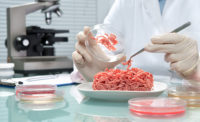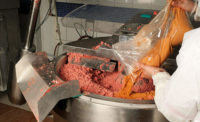I like to say the food industry is a dynamic landscape of innovation. A case in point is how the basic business model is ever changing.
We have gone through cycles in which it made sense to put the facility near the source of the raw material, i.e. large slaughter facilities in the West. We have gone through cycles during which it made more sense to have a mid-size facility and locate it at a strategic location. We then moved to the distribution houses and the cycle continues.
The trend we see now has small to midsize companies building a second smaller facility rather than a bigger plant. In many cases this leads to a third smaller plant. Many of these facilities have fewer than 50 employees and in some cases are either partially or wholly owned by large corporations. With most, however, it is either an investment group or an entrepreneur who is nimble enough in the market to be successful.
When a large established company procures a smaller operator, I typically see cultural issues. The small operator is usually an artesian style production facility with unique food safety issues and systems that are totally different that the manufacturing-style production systems and issues that are faced by larger facilities. Having everyone on the same page from the outset is critical.
The challenge in these situations is staying focused on why the smaller operator was procured. Traditionally, it was to acquire innovation or a brand name. Now we are seeing it as an overall market strategy to penetrate and hold market share. In the last year we have been involved in about a dozen of these type operations. In all cases, the intent is for the larger company to leverage the innovation across its portfolio of facilities while at the same time operating the smaller operation as an independent entity.
As with any business model having multiple small facilities that each specialize in a product type or on the “buy local” trend, food safety challenges are created. In this case, the challenges are often multiplied because of the resources (can we say qualified food safety personnel) available to the enterprise.
When the company is owned by an investment group or single entrepreneur, I typically see three basic ways the food safety and quality (FS&Q) team are set up: traditional; centralized; and total integration.
In the traditional setup of a FS&Q team, there is a corporate director or vice president who manages food safety for all facilities. In this model, the director reviews the food safety plans, FS&Q operations, etc., at each location. Each of the facilities will have a FS&Q lead or manager and, depending on size and complexity, one or two technicians. The technicians handle the recordkeeping and implementation on the floor while the lead manages the verification activities, developing and approving the food safety plans as well as handling the daily FS&Q activities at the plant level. The lead and technicians report directly to the plant manager.
The pros to this model are a dedicated staff, most problems are handled at the plant level and your plants operate independently, giving them the flexibility to innovate at the local level. The cons are it is the most expensive way to operate, you have higher resource expenditures, changes are often made without the strategic goal in mind and innovation is often stovepiped, i.e. your other facilities can’t take advantage as well.
The centralized setup is like the traditional method. It entails a minor reduction in staff. You will have a corporate director who writes the food safety programs for each facility and a technician in each facility. The technician handles the recordkeeping and implementation on the floor. Many of the recordkeeping tasks are off-boarded to production employees, depending on what you are producing. Verification tasks are either done by the technician, plant management and/or the director during site visits. The technician reports to the plant manager. There is no lead in this situation, as the duties that he or she would traditionally perform are given to either the director or the technician.
The pros to this model are reduced consumption of resources (the FS&Q plant-level managers are eliminated), you have a director who must be intimately aware of how each facility operates and can cross level efficiencies between the facilities, and you have standard practices between all facilities making cross leveling of personnel much easier. The cons are your director must spend more time at each facility, you must have operations personnel trained as backups for your technician(s), and operations personnel must also take time away from production to perform documentation tasks.
The total integrated system requires the use of additional resources including electronic data flow. In the integrated system, you have a corporate director of FS&Q and a corporate technician. At the plant level, your operations personnel perform all tasks, recordkeeping, verification tasks and more. All official records are electronic, so the corporate technician performs the actual records review and pre-shipment review remotely. The director writes all programs and pushes them to the plants and subsequently trains on implementation. For example, the director establishes a program and creates the recordkeeping system. He or she then trains the plant operations team on how to implement the program to include completing the records. Plant operations teams complete the applicable records and the corporate technician reviews them and performs pre-shipment reviews.
The pros to this model are greatly reduced staffing, centralized control of facilities, and the ability to make decisions based on live trending data. The cons are the need for a solid information technology (IT) infrastructure, the cost of implementing computer systems and the cost of having operations staff diverted from making product to recordkeeping and FS&Q-related tasks.
Each of the models have situations in which they make the best sense to implement. For example, if you have three facilities in very close proximity to each other and you have a strong IT infrastructure, the third scenario will offer the greatest return on your investment. If your facilities produce unrelated products, have poor IT resources and are geographically spread out the first scenario may make the most sense. The centralized setup is typically a step toward the integrated model; however, we are seeing it as a viable long-term strategy successfully implemented by several companies.
Regardless of the configuration you select, the key for any of them to work effectively is having trained employees carrying out your FS&Q tasks. When you make the decision to buy or build a new facility, I always recommend incorporating a training budget in your initial plans. Finding out on the first day of production that you have failed to perform a critical FS&Q task because the responsible employee didn’t know how to do it is a recipe for disaster. As part of the training for your FS&Q staff, I also suggest training on how to interact with your customers. When you are operating a small facility, they will be required to do so at some point and if they can articulate your program and your dedication to high-quality products, they will ultimately help increase sales.
Even when they are not directly interacting with your customers, the FS&Q team sells your products by making sure you have consistent products that are safe and wholesome. When you have multiple small operations, it is critical for everyone to understand they are part of the sales team and that even though they may not be directly interacting with the customer daily, everything that they do has a direct impact on the bottom line. As I have mentioned in the past, your FS&Q team is a sales force multiplier. Don’t be afraid to leverage them into greater sales.
The new paradigm of multiple small operations under one umbrella company, while presenting challenges, also provides opportunities to enter market segments by being responsive and nimble in ways that large facilities just can’t duplicate. In these types of companies, we see true innovation not just in food safety, but in product development, price models and in employee retention. If you are thinking of expanding, buying into the industry or want to expand into the production/retail sales areas, this model is worth reviewing. NP





Report Abusive Comment